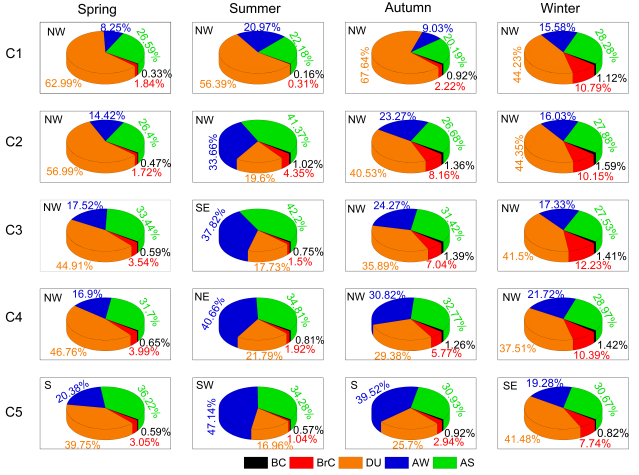A newly released study finds that the columnar aerosol properties in different seasons change a lot, and are related to the air mass origins, according to the research team led by Prof. ZHANG Weijun at Anhui Institute of Optics and Fine Mechanics (AIOFM), Hefei Institute of Physical Science, Chinese Academy of Sciences.
Knowledge of the physical and chemical properties of atmospheric aerosol is key to bettering our understanding of the environmental impacts of the particles.
However, the varied vertical distributions of aerosol composition and the mixture of local sources with regional transport add complexity to the study of atmospheric pollution.
To tackle the problem, the team carried out comprehensive analysis on the relationship of regional transport and columnar aerosol properties in Beijing. Dr. WANG Shuo, one researcher of the group, presented the first attempt to analyze columnar aerosol types and chemical components in different air mass sources based on 10-year columnar aerosol optical properties in Beijing.
Daily air mass backward trajectories were computed and categorized into five clusters. The columnar mass concentrations of black carbon (BC), brown carbon (BrC), dust (DU), aerosol water content (AW), and ammonium sulfate like aerosol (AS) of each cluster were retrieved from the optical data obtained from the Aerosol Robotic NETwork (AERONET) with five-component model.
The group found that the columnar aerosol properties in different seasons change a lot, and are related to the air mass origins.
In spring, aerosol is dominated by coarse particles. Summer is characterized by higher single scattering albedo (SSA), lower real part of complex refractive index (n), and obvious hygroscopic growth due to humid air from the south. During autumn and winter, there is an observable increase in absorption aerosol optical thickness (AAOT) and the imaginary part of complex refraction (k), with high levels of retrieved BC and BrC. However, concentrations of BC show less dependence on the clusters during the two seasons owing to the widely spread coal heating in north China.
The results of this work can be used to evaluate the contribution of regional transport to aerosol components quantitatively with more AERONET site of potential impact areas and to predict air quality in a particular region.
This research was supported by the National Natural Science Foundation of China (41330424), the Natural Science Foundation of Anhui Province (1508085J03), the Youth Innovation Promotion Association CAS (2016383), and the China Special Fund for Meteorological Research in the Public Interest (GYHY201406039). (十日内)
Link to the paper: Dependence of columnar aerosol size distribution, optical properties, and chemical components on regional transport in Beijing

Fig. 1 72-hour daily air mass backward trajectory clusters ending at Beijing in four seasons, together with satellite products from Aqua level 3 products using as the background. (Image by WANG Shuo)

Fig.2 Average of volume fractions for five components in different seasons and different clusters.(Image by WANG Shuo)
Contact:
ZHAO Weixiong
Anhui Institute of Optics and Fine Mechanics
Tel:86-551-65591961
E-mail:wxzhao@aiofm.ac.cn
 Tel: +86-551-65591206
Tel: +86-551-65591206
 Fax: +86-551-65591270
Fax: +86-551-65591270
 Emai: zhous@hfcas.ac.cn
Emai: zhous@hfcas.ac.cn
 350 Shushanhu Road
350 Shushanhu Road